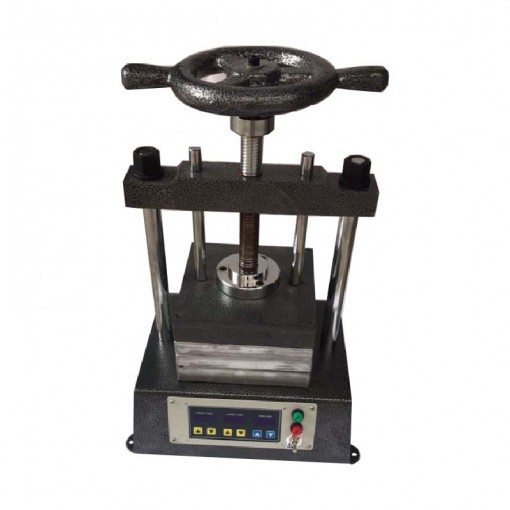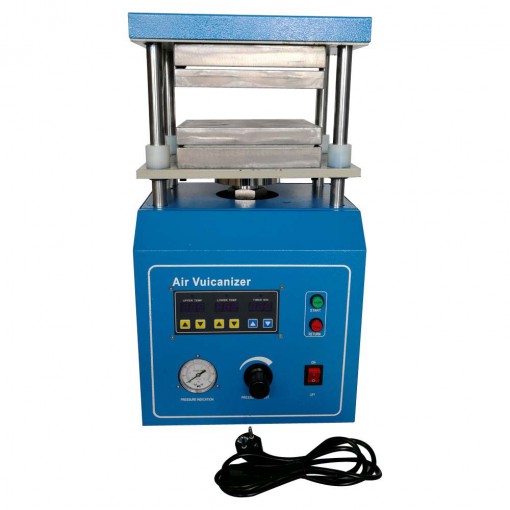Jewelry mold makers have many problems with vulcanizing silicone and natural rubbers. This is usually due to improperly or faulty vulcanizing presses.
- The mold will not cure properly if the temperature drops too low.
- The rubber may become stiff if it is heated too much. Rubber can also shrink to an extent and turn into liquid.
- Molds will curl if the heating plates are higher or lower than each other.

Problems with the Vulcanizer are caused by:
- Incorrectly set thermostats
- Faulty thermostats
- Faulty heating elements or badly damaged heating elements
Many jewelry industry vulcanizers have unreliable or cheaply manufactured controls. This is partly because jewelry mold rubbers tend to be very tolerant of errors. Although this is a good idea, things can sometimes go wrong.

The wise mold maker will use a thermometer to check the temperature of the vulcanizer regularly, just like one would check the oil level in his car.
You can mark required temperatures using a pen, pencil or any other tool if your vulcanizer is equipped with both a knob or a round dial. It will be evident if the dial was accidentally moved.
To prevent unauthorised changes, you might want to remove the adjusting knob from your dial if your workspace is shared with others or if children are involved in your work.
These dials can be wildly inaccurate and you should not believe the temperatures they indicate.
Your vulcanizer may have one or more digital temperature controls. This will make it less likely that you’ll experience an issue and not know about it. However, even the best-made machine can fail.
Some vulcanizers allow for the installation of a thermometer by drilling a hole through the top or bottom plates. While this is better that nothing, it won’t give accurate readings. For example, if the topplate is too cold or hot, the thermometer will not display that.
It is better to place the thermometer between the plates than not, but it will still not give a precise reading. The thermometer will only display the average of both the temperatures if the plates have different temperatures. If the temperature readings are 50 degrees too high on one plate and 50 degrees too low on the other, they will both be accurate. Castaldo has provided photos of his recommended technique. For a disposable and cheap insulator, place a small piece of wood about 1/2″ or 3/8″ between the plates.
First place your probe on top of the wooden surface and then under it. Also, if you have a large vulcanizer, measure both the right and left sides of each plate. The plates should be closed quickly so that the probe of the thermometer does not get damaged.
As with all electric heating devices, vulcanizing presses can be set to a temperature and then switched on and off according to the thermostat. You can see the process in vulcanizers that have a temperature-indicating light. The press is at the top of its cycle when the lamp goes out. When the lamp comes on, the cycle is at the bottom.
Consistently take temperature measurements at each stage of the cycle.
Vulcanizers equipped with digital temperature controllers can maintain an even temperature of 1 to 2 degrees. Older models would have a range of 5-10 degrees, although we have seen many cases with 25-degree and 50-degree temperature differences.
Let the vulcanizer heat stabilise for about an hour before you start your tests. You will need to measure the temperature of one area, keep an eye on it for several cycles, and take note of the temperatures. You can then repeat the procedure for the second plate, or, in case of larger presses, the right and left areas.
This is not a time to stand and watch as the machine goes through its operation. It’s enough to do other things, and only check the vulcanizer occasionally.
Both digital and dial thermometers work well. Glass thermometers are also possible to work, but may break during this process.
It’s easy to adjust the temperature setting by using dual controls on your vulcanizer.
It may be difficult to achieve the correct temperature if there is only one control for both plates. For a temporary solution, you can take the mold out of the press at half-way. Turn it over and then put it back into the press for the remaining time. This could reduce temperatures.
You can either repair or replace the machine, more jewelry casting & melting machine at our store.